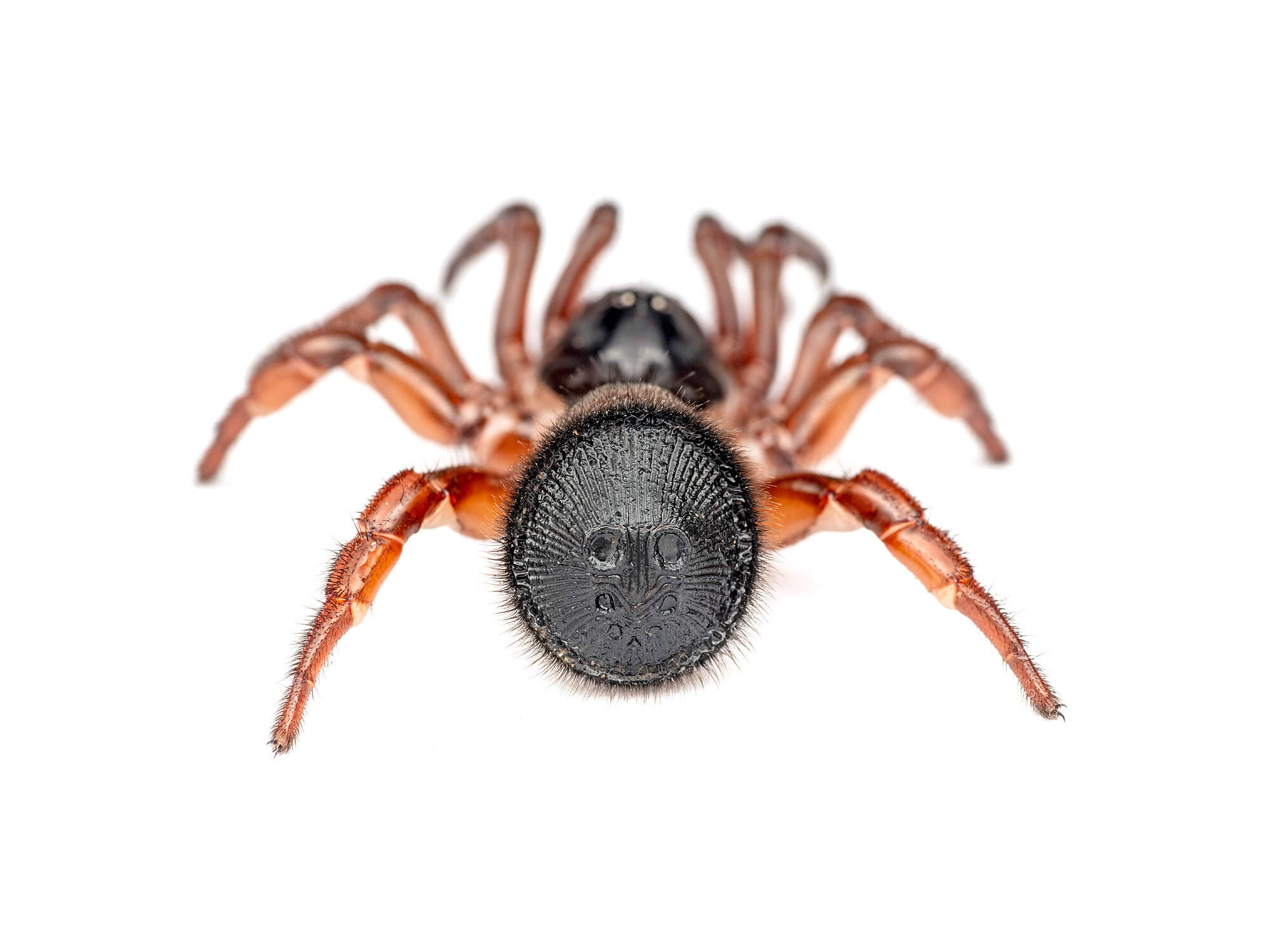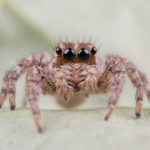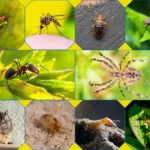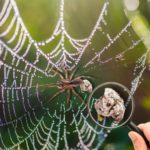Ever gone hunting? Many of you know that the #1 rule of hunting is to hide from your prey and then abruptly hunt. Humans, as well as animals and insects, are aware of this rule. They hide and then seek their prey. If we talk about insects, spiders particularly, there is a species of spider that very smartly hunts. Such spiders have a unique way of hunting. These spiders are known as Cork-lid trapdoor spiders. The majority of these spiders live in tropical areas across the world. There are few species found in Southern Europe, but most are abundant in the South and West of the United States. Such trapdoor spider species live in various habitats like wooded riverbanks and deserts but usually favor steep slopes and sandy areas.
The Cork-lid trapdoor spider species include Tenizidae, Ctenizidae, Cyrtaucheniidae, Halonoproctidae, Idiopididae, Actinopodidae, and Liphistidae. These spiders are famous for their unique ability to dig a tunnel and construct its door. Now the question arises as to why they are called trapdoor spiders. The reason is that these spiders use tightly fitting silken hinged doors that seal off the entrance of their tunnels. However, the cork-lid trapdoor spiders are the most widespread species of the subfamily Mygalomorphae and comprise the tarantulas. A genus of Mygalomorph trapdoor spiders in the Halonoproctidae family is called Cyclocosmia.
Table of contents
- Identification
- Cyclocosmia Trapdoor Spider
- Interesting Facts
- Different Species
- Cork-Lid Trapdoor Spiders Burrow
- Cork-Lid Trapdoor Spiders Hunting
- Is Cork-Lid Trapdoor Spider Poisonous
- Is Cork-Lid Trapdoor Spiders Harmful To Humans
- Cork-Lid Trapdoor Spiders Rivals
- Identification of Different Cork-Lid Trapdoor Spiders
- Final Thoughts
Identification
The term “trapdoor spider” refers to a group of tropical spiders that live beneath the earth. Their name comes from the cork-like trapdoor they construct at their nest’s entryway. Do not mistake funnel-web spiders, which are larger and more hazardous, for Cork-lid trapdoor spiders. These Trapdoor spiders, however, don’t have the dark mottled patterns of funnel-web spiders.
A medium-sized mygalomorph spider known as a trapdoor spider builds cork-like trapdoors for its tunnels out of mud, plant, and silk. This elusive cork-lid trapdoor spider is just over 1 inch long and is small. These tiny tarantula cousins have a glossy exterior and a black or brown appearance. They have two body segments and eight legs, just like other spiders. They may live up to 10 years, a pretty long lifespan.
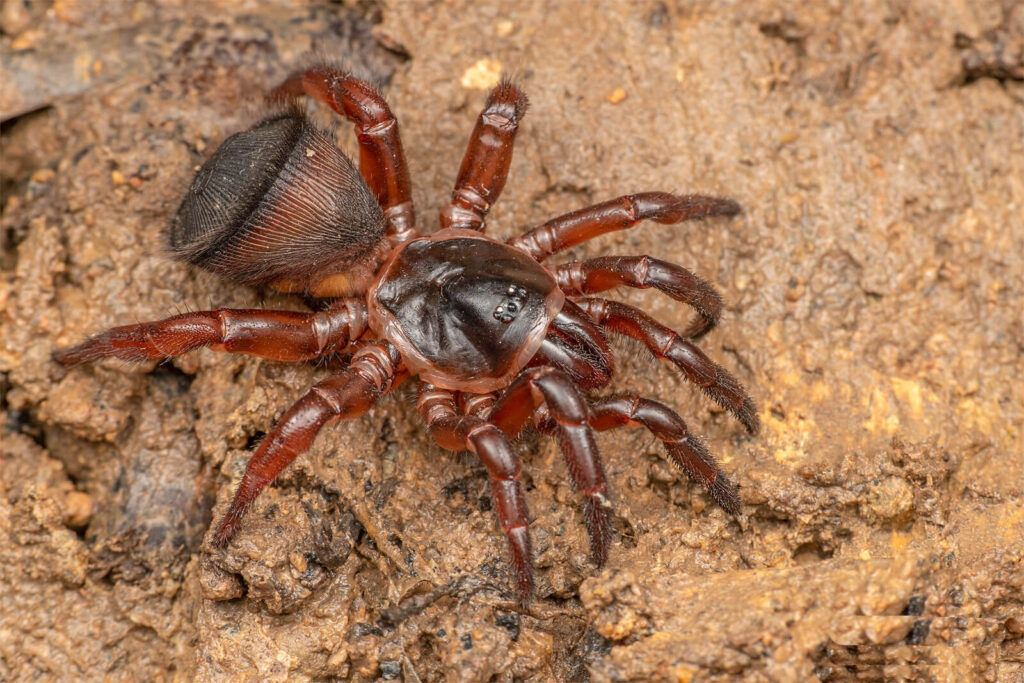
Cyclocosmia Trapdoor Spider
This spider has many common names, ranging from Cork-Lid Spider, Oreo Spider, Butt-Plug Spider, Ravine Trapdoor Spider, Button Spider, Butt-Door Spider, Aztec or Inca Coin Spider, Happy-Bum Spider, and possibly many more. These spiders are also known as Chinese hourglass spiders.
This large, thick-legged spider appears like an hourglass; its stomach or back half has been cut. The spider appears as a sturdy, flat, round shield from behind that resembles a maintenance-hole cover. Six round dents may be found in the shield’s middle. The spider has eight eyes, four above and four below.
Interesting Facts
- An interesting fact about cork-lid trapdoor spiders is that they do not produce webs like most other species since they are a genus of trapdoor spiders. Instead, they have a trapdoor-like structure with a depth of 2.8 to 5.9 inches on top of their tunnel (burrow).
- The most interesting thing about these cork-lid spiders is that when they perceive danger, they use the extremely toughened rear end of their abdomen to “shut” their burrow.
- Each species’ sclerotized pattern may differ. Usually, it resembles an Inca or Aztec coin.
- Although the spider is a chunky and magnificent creature, yet, its true objective is to gather food rather than bite people.
Different Species
Species of trapdoor spiders include those in the Cyclocosmia genus. These spiders are predatory animals that await an unwitting victim to sneak past their nest before striking. These spiders are considerably smaller and have less hair on them. Their amazing yet delectable abdomens may recognize them. Although all members of the Cyclocosmia genus appear to have flat abdomens, several species may be distinguished by their distinctive differences. These species have different sclerotized disc patterns. They are defensive structures that are challenging to break.
Cork-Lid Trapdoor Spiders Burrow
Cyclocosmia Cork-lid trapdoor spiders often construct their tunnels in steeply sloping banks of sandy clay. Typically, a layer of leaf litter and moss is placed on top of a trapdoor made of silk that has been combined with dirt. Because of the remarkable success of their trapdoors’ camouflage, Cyclocosmia spiders are exceptionally difficult to discover in the wild, like many other ctenizids. As a result, they are frequently considered to be one of the rarest spiders.
The cork-lid trapdoor spider’s sclerotized disc serves as a specific behavioral deterrence to keep predators out of their burrows. The abdominal disc provides an unbreakable fake ceiling as the spider dives headfirst into its tunnel, fitting closely against the rounded walls it creates around the burrow.
Cork-Lid Trapdoor Spiders Hunting
The tunnel of the cork-lid trapdoor spider is a vertical tube with a smaller bottom. This spider builds a hinged entrance out of a silk wafer at the top of the burrow and drapes the walls with the same silk. With the help of dirt or fallen leaves, it covers the door from the outside. To capture passing insects and other arthropods, the spider hides behind its trapdoor and waits. When a parasitic wasp or other predator manages to get into the burrow, the spider dives to the bottom head first, leaving the predator with nothing but its strong barrier. The sclerotized disc is attached to the burrow’s walls so firmly that it is nearly hard to remove the spider.
The “trapdoor” that these spiders build has a silk hinge on one side and is made of soil or plant matter. The spider then waits for its prey, and it attacks when its prey animal wanders close by. The prey then leaps out of their burrows to catch its food when disturbed by the silk “trap” threads.
The cork-lid trapdoor spider feeds on small vertebrates, crawling insects, and other arthropods, such as spiders, wasps, or flies. It either sits with the door of its burrow slightly ajar and its front legs extended when it waits for its prey, detecting it from behind the closed trapdoor. These spiders’ legs include sensitive hairs that may detect vibrations from approaching prey, and they abruptly attack.
Is Cork-Lid Trapdoor Spider Poisonous
A cork-lid trapdoor spider has venom in them, but they use it to prey. When capturing its prey, Cyclocosmia does use venom, although it only targets insects and other small-bodied arthropods. These spiders use their two jaws, which include hollow fangs through which they may inject poison, to kill their prey. However, they do not necessarily inject venom if they bite in defense.
Is Cork-Lid Trapdoor Spiders Harmful To Humans
The first thought that comes to mind whenever a strange-looking insect is spotted is, does it bite? Is it venomous? Or can it harm people?
To all of these queries: the answer is; No, this unusual yet exquisite work of art-type cork-lid trapdoor spider is neither dangerous to people, and it is not venomous. When provoked, this spider’s bite would not be deadly and have the same unpleasant sensation as a wasp sting.
Additionally, even without injecting venom, these trapdoor spiders’ jaws are large enough to rip through human flesh, but only in self-defense work.
Cork-Lid Trapdoor Spiders Rivals
The predators of cork-lid trapdoor spiders themselves are diverse in numbers. In contrast to other predator animals and birds, the Australian bandicoot (Guinea) digs these spiders out of the burrow openings. Sometimes, Centipedes and scorpions follow trapdoor spiders when they enter their burrow. Furthermore, some female wasps can locate these spider’s burrows and eat them through the door. The wasp then stings the poor spider to make it motionless and then lays her eggs on its abdomen. Later, the live but defenseless spider is slowly devoured by the larvae or caterpillar when the eggs hatch.
A trapdoor spider flees inside its burrow when threatened. Spiders with cork-like doors strongly resist attempts to pry them open by clinging to the inside with their claws or fangs.
Identification of Different Cork-Lid Trapdoor Spiders
| Name | Size | Burrow | Characteristics | Location | Venomous |
| Ctenizidae | 2-2.5 inches | 6 inches deep | Smaller Less hairy | Europe, Turkey, France, and Italy | No |
| Euctenizidae | 0.5 to 1.2 inches | Un-branched tube burrow 2.8 to 9.8 in | wafer-like doors to their burrows | United States & Mexico | No |
| Halonoproctidae | 0.5 to 1.5 inches | Tube-like burrow | Large, somberly colored spiders, Few spines on the body | America, Australasia, Asia, southern Europe & North Africa | No |
| Cyclocosmia | 1 to 1.5 inch | 2.8 to 5.9 inches | Their disks have strong spines around the edges | Australia | No |
Read More: A Complete Guide to Unveiling the Enthralling World of the Red House Spider
Final Thoughts
It is impossible to come upon these cork-lid trapdoor spiders by chance since they are an uncommon species. However, if you find something unusual, such as an ancient coin dug up from the earth in a tropical area, leave it alone and do not disturb it. These spiders are unique in every way. However, you all surely have learned from this article that not all strange-looking insects are deadly. But in the near future, my people, tread cautiously.

